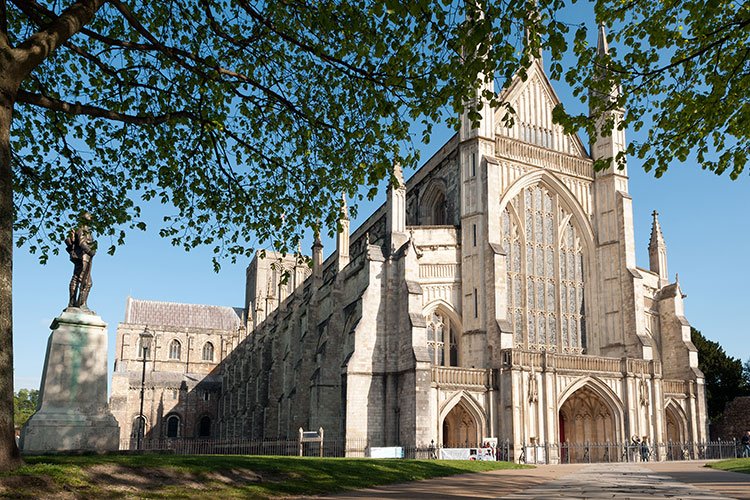“It was as if I’d come home, or at the very least seen an old acquaintance. ”
In this issue, author Riley Joyce discusses Jane Austen’s profound impact on his life.
It’s strange how you can never meet someone, and yet you have an idea of who they are. Granted, it’s your perspective of their personality, and has more to do with your view than it does with them as an individual. It doesn’t mean one’s perception is wrong, just tinted a little. As with any celebrity, living or dead, Jane Austen means different things to different people. No doubt she’ll continue to inspire and, yet her greatest admirers can only feel her in spirit.
The first time I had read Jane Austen I had little sense of who she was. I knew little of the Regency, and even less about her work. That era of history was glossed over in the public schools. I found myself learning about her world through the excellent Oxford University editions with the explanatory notes at the back. It was through there that I was turned onto the Regency, and the ritualistic way of life Jane and her contemporaries would have lived. The first of her novels that I’d explored was Emma. I do mean explored in the sense that this was uncharted territory for me. Each novel was a new land to be discovered, and each turn of phrase was an education in and of itself. For a guy with a background in science fiction and mystery, this was something entirely out of the ordinary for me. I loved it. I loved the challenge, in much the same way that Shakespearean actors and scholars are challenged by The Bard’s tongue-twisting verbiage. It’s through such a challenge that I began to learn and grow as well. I was a teenager at the time.
Highbury, Emma (2009)
As I’d entered a few chapters into Highbury and its environs, I formulated something unique. I began to imagine Jane reading the words aloud. I then began to imagine what her body language would be like, her accent, and even how the sunlight would shine through the window near her writing table, and how it would illuminate the pages and the fabric of her dress. It was from her witticisms that I began to get a sense of who she was. It was as if she was reading directly to me, and that made it more intimate than just mere words on a page. The sense that I was being reached out to from centuries before was like a message in a bottle. It floated to me in the latter days of the 20th century, and I was more than willing to open it.
It was the mid-90’s when I discovered Jane and her times. Yes, the 1995 Pride and Prejudice was a gateway for me, as it was millions of Janeites the world over. All I knew then was, “Saffron from AbFab is in this.” Julia Sawalha famously played the unruly Lydia Bennet in that adaptation. Since then, I think we’ve all made our lists of favorite adaptations, and least favorite ones. But that’s another story…
Julia Sawalha as Lydia Bennet, Pride and Prejudice (1995)
As for myself at that time…well, I wasn’t in the best shape. I had entered a bad depression in my teens and didn’t start to emerge from it until my late twenties. I needed something to hold onto then, and in the days before social media, feeling I’d discovered something new helped make a stagnant period in my life feel less uncomfortable. For just a few hours a day I could time travel, and in those moments, spend time with a woman that I felt I could relate to personally. Jane’s wit and, and her maxim of, “My characters shall have, after a little trouble, all that they desire,” were both appealing. Who doesn’t love a happy ending?
Fast forward to the 21st century. A month after my mother passed away, I began the first of many pilgrimages to the UK. At that time, I visited Stratford-Upon-Avon and London. But it wasn’t until a year later that I visited Bath and Winchester Cathedral, and other prominent Jane sites. I remember this vividly, and I carry this experience with me and think of it often. On the tree-line approach to Winchester Cathedral I thought to myself, “This must be what the entrance to heaven looks like.” I’ll admit I was nervous, and once I was clear of the trees and saw the cathedral, I had a sense of its looming enormity. Then came a sense of familiarity. It was as if I’d always been there, despite having just visited for the first time.
Winchester Cathedral, where Jane Austen is buried
Then I came to Jane’s grave. I knew what was written on it, having read the inscription in the beginning of Persuasion. Seeing the tombstone was another story. It looked as if it had just been laid on the floor of the cathedral. Prior to this I had seen Jane’s letters in glass cases, as this was the lead up to the 200th anniversary of her passing. The first editions of her novels were prominently displayed as well, and once again it was as if time had reversed itself. I was alone at the foot of her grave, and it seemed like an eternity had passed. Time seemed to freeze, and once again I had that sense that she was reading to me. Then, in my mind’s eye, I could see her standing there.
It wasn’t a hallucination or anything extreme. Instead, I just pictured how she would have looked based on family descriptions of her and Cassandra’s famous watercolor. I envisaged Jane as having auburn hair, hazel eyes, and a slender frame. I’ll admit, she was just slightly taller than me, at least by an inch. In that moment, I could hear her voice reading aloud. I had a flashback to reading Emma for the first time, and suddenly it was winter of 1996 instead of summer of 2017. It was as if I’d come home, or at the very least seen an old acquaintance.
Cassandra Austen’s portrait of Jane
I don’t know how long I stood there, but when it came time to go, I didn’t want to leave. I felt like doing so was abandonment, like I should stand guard over her tomb. But just as I was leaving, the sun came out of hiding. It had been a gray, overcast day before then, and suddenly the stained-glass windows at the front of Winchester were shining. I took a photo of them, and for years kept a copy of it tacked up at my desk at work. That feeling of, “Once you’ve been there, you’ve always been there,” has never left me, even writing about it now.
After I left the cathedral, I saw the house where Jane died. It’s just around the corner, and I had a sense of the short procession her funeral would have taken, with only a handful of male mourners, as was the custom back then. Then on the reverse of all this, I visited her cottage a year later. On that sojourn, I had another similar experience when I was alone in her bedroom for a few minutes. I had this incredible sense of belonging and love. Like I was being given so much affection, but it wasn’t too much or too little, just right. It was like she was welcoming me there. It was this feeling that can’t be described but must be felt. It was like I was supposed to be there. I haven’t felt that way while visiting a place before, but I felt it then and am still grateful for the experience.
Jane Austen’s final resting place
Now, skeptical types will suggest that I had some kind of grief-induced emotional response. Perhaps I did, but it was based on someone who’d lived over two-hundred years ago, and yet I feel connected to her. I feel that Jane is someone whose brainwaves ran on similar patterns as my own. She was constantly observing, commenting, and taking in the world around her. She was creative and curious. As with any historic place I’ve visited, the people who occupied them become very real to me, and cease being illustrations in books or words on a page. There goes the concept of the forward progression of time, and the cyclical nature of the seasons again, as if they could be reversed through such visits. Perhaps, in a way, they can be?
Everyone has a different view of Jane Austen. She’s either a loving friend, a pioneering feminist, a brilliant satirist, or someone they are assigned to read in English lit class for their A-Levels in Britain.
Plaque at Jane Austen’s House
She means something different to every one of us. To Caroline Jane Knight, she is Aunt Jane. To filmmakers, she is the inventor of the romcom, a controversial title. Still to others, she’s about to be rediscovered and read and reassessed. As no doubt generations for the next two-hundred years, and beyond, will continue to do. I can only imagine what they’ll make of her. But I know they will interpret her work in their own way, and many more Janeites will make the pilgrimage as so many of us have done. Just don’t be surprised if there are Regency groups on Mars in the future. Or a version of Sense and Sensibility set on the moon’s Sea of Tranquility. Whatever the future makes of her, Jane will always be around.
For me personally, I feel like I’ve known her all my life. Except she’d be twice as sarcastic and witty as anyone can imagine. A woman who once wrote, “I will not say that your mulberry trees are dead; but I am afraid they're not alive,” is the sort of woman I’d love to know. One day, I may have that chance to trade witticisms with her. But it will be an exceptionally long time from now, God willing. Until then, I will continue to have my visions of Jane with quill in hand, sitting at her desk, and letting the ink flow into eternity, and into our hearts and souls.
© Riley Joyce 2023. Riley Joyce is an aspiring writer. He made his professional debut in 2022. Best known for the Eden Ray crime and mystery novels, he’s currently writing a science-fiction novel involving artificial intelligence. Mr. Joyce lives in the United States.
New!
Welcome to the Jane Austen Literacy Foundation Book Club.
Our Book Club will include a rich program of Jane Austen and other books that inspire.
You are welcome to join the monthly book club discussions absolutely free, or become a member to enjoy a wide range of extra benefits; special guests, authors, exclusive content, exclusive bookish extras, and more!
Your membership will directly support the work of the Jane Austen Literacy Foundation. Connect with fellow book lovers who share your passion for meaningful reading and making a positive difference. Share insights, engage in discussions and events, and enjoy all the membership benefits that come from being a part of the community. Click below to find out more about our book club and membership benefits:









